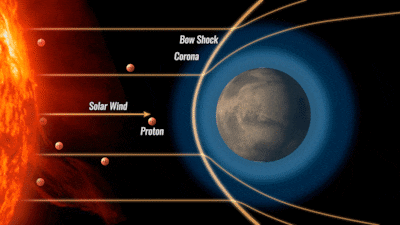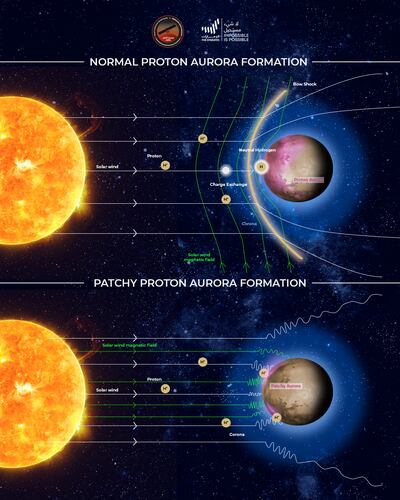The UAE’s Hope probe has discovered a new type of proton aurora on Mars that is scattered on the dayside of the planet.
Aurorae are colourful lights that appear on a planet when solar activity disturbs its atmosphere.
All observations by Nasa spacecraft so far have shown that proton aurorae appear in a uniform manner, while the latest discovery by Hope shows there are patchy ones scattered across Mars’s dayside.
This latest data observed 'patchy' proton aurora throughout the full disk of the planet on August 2021, and in a small portion of the disk on August 30, 2021.
The data was combined with input from Nasa’s Maven spacecraft, which measured the planet’s plasma environment while the aurora events were happening — helping to reveal all areas where the solar wind was raining down onto the planet.
These latest findings will help give scientists new insights into the planet’s mysterious atmosphere.
Hessa Al Matroushi, science lead of Emirates Mars Mission, said that the discovery “lifted the lid on entirely new possibilities for scientific research”.
“Our discovery of these patchy proton aurorae adds a new kind of event to the long list of those currently studied by EMM and challenges our existing views of how the proton aurora on Mars’ dayside are formed,” she said.
How does the patchy proton aurora form?
On Earth, the aurora borealis and aurora polaris — known as northern and southern lights — happens when protons and electrons from solar wind hit particles in the atmosphere, causing colourful lights in the sky.
On Mars, however, because of the planet's lack of a global magnetic field and localised crustal magnetic fields in the southern hemisphere, there are three types of aurorae — proton, diffuse and discrete.
Proton aurora is the only one scientists know that appears on the dayside of Mars.

It forms when solar wind protons, which are hydrogen atoms stripped of their lone electrons by intense heat, interact with the upper atmosphere on the dayside of Mars.
Now, observations by Hope’s ultraviolet spectrometer ― one of its scientific instruments ― have shown that the aurora also manifests as bright regions scattered across the dayside of the planet in two ultraviolet wavelengths associated with the hydrogen atom.
The patchy type of proton aurora is formed when solar wind directly affects the dayside upper atmosphere on Mars and emits ultraviolet light as it slows down.
When this aurora occurs, small regions of the planet become much brighter at these wavelengths, helping the spacecraft observe intense localised energy that builds up in the atmosphere.
“We know that these wavelengths are only emitted by the hydrogen atom, which tells us that super energetic hydrogen atoms must be present in the atmosphere in order to produce the auroral emission,” said Mike Chaffin, EMM’s science team member and lead author of a newly submitted paper on the proton aurora.
Hope has observed patchy aurora multiple times over the course of its mission so far, and the shape of the aurora is not always the same.
On August 30, for example, the patchy proton aurora was confined to a much smaller portion of the disk than on August 11, suggesting a different mechanism may be at work.
Mapping all areas where solar wind struck the planet
Through a data-sharing partnership with Nasa’s Maven mission, scientists were able to study the planet’s plasma environment while the aurora was happening.
This helped to show the patchy aurora can only be produced by plasma turbulence in the space surrounding Mars.

Plasma turbulence on Mars can occur under a variety of conditions, and different shapes of patchy proton aurora may reveal different plasma conditions.
“In the August 11 observations the aurora is so widespread and so disorganised that the plasma environment around Mars must have been truly disturbed,” Dr Chaffin said.
“Thanks to Maven measurements of the Mars plasma environment simultaneous with the aurora, we can confidently say that the solar wind is directly affecting the upper atmosphere wherever we’re seeing auroral emission.
“What we’re seeing is essentially a map of where the solar wind is raining down onto the planet.”
Not the first time Hope has discovered a new type of aurora
The Hope spacecraft, which has been orbiting Mars since February 2021, has made discoveries in the past that shed light on other types of aurora.
In June last year, it revealed a new type of discrete aurora on Mars' night side atmosphere. Scientists called it the "sinuous discrete aurora", a huge, wormlike aurora that extends halfway around the planet.
It is made up of long worm-like streaks of energised electron emissions in the upper atmosphere.
These extend many thousands of kilometres, stretching from the day side into the night side of Mars.
The aurora was imaged when the planet was experiencing the effects of a solar storm, which caused a more turbulent stream of solar wind electrons than usual. This allowed Hope to make bright and extensive observations of the aurora.




